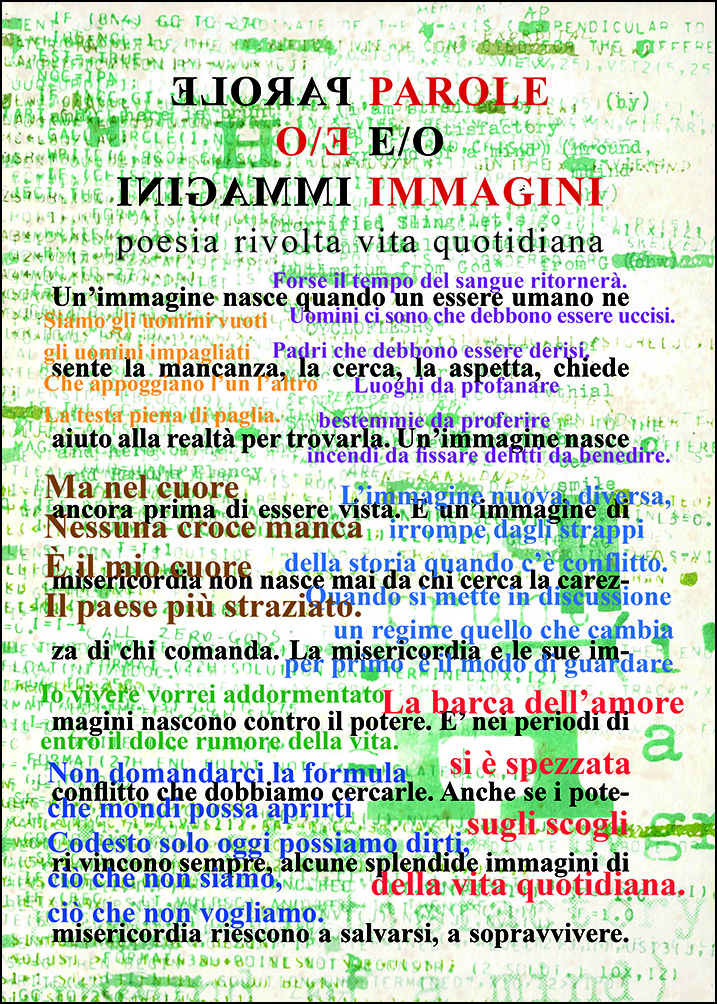L'ARENGARIO STUDIO BIBLIOGRAFICO - Dott. Paolo Tonini
Parole e/o immagini. Poesia rivolta vita quotidiana
Luogo: Gussago
Editore: L'Arengario Studio Bibliografico
Stampatore: prodotto in proprio
Anno: 2023 (22 maggio)
Legatura: brossyra
Dimensioni: 29,7x21 cm.
Pagine: VIII - 32 (2) compresa la copertina
Descrizione: copertina illustrata con la riproduzione della copertina del libro di Emilio Villa «Options» (Macerata, Casa Editrice d’Arte Foglio, 1968) con un collage di parole di Tano D’Amico, Thomas Stearns Eliot, Franco Fortini, Vladimir Majakovskij, Eugenio Montale, Sandro Penna, Giuseppe Ungaretti. Design e testo introduttivo di Paolo Tonini. Catalogo interamente illustrato a colori, 32 schede ragionate, pubblicato in occasione di «BOOKS Festival del Libro d’Arte» (Bologna, MAMBO, 26 - 28 maggio 2023). Edizione digitale.
Bibliografia: N. D.
Prezzo: N. D.ORDINA / ORDER
"A cosa servono le parole e le immagini? Le parole e le immagini che servono non contengono pensieri e sentimenti: servono per comandare, segnalare, legiferare. Sono parole e immagini perfette per una intelligenza artificiale. Non sono queste le parole e le immagini della poesia. La poesia si fa con le parole e le immagini che non servono. [...] Le parole e le immagini che non servono seguono il destino dei movimenti di rivolta e delle utopie. Si tolgono dal tempo, non sopportano l’orrore della storia. La storia, tanto reale che razionale, si fa da sé con la necessaria inconsapevolezza di tutti. Rimane nella memoria l’ebbrezza dei momenti in cui tutto è sembrato possibile, e per questo è scorso il sangue. [...] Dopo la pandemia col suo ossimoro imbecille «Io credo nella scienza» e una guerra che chiede sempre più armi e carni da macellare, chi sono, dove sono i fratelli? «Perch’i’ no spero di tornar giammai» alla felicità che azzardavo possibile. Restano per domani agli insommessi le tracce dell’ebbrezza e del dolore, nella penombra di una biblioteca e nel silenzio della poesia" (dal testo introduttivo).
"What are images and words for? The words and the images that are serfs do not contain thoughts and feelings: they are for commanding, signaling, legislating. They are perfect words and images for an artificial intelligence. These are not the words and images of poetry. Poetry is made of words and images that are not serfs. [...] The words and the images that are not serfs follow the fate of revolt movements and utopias. They remove themselves from time, they cannot bear the horror of history. History, both real and rational, makes itself with the necessary unawareness of all people. The thrill of the moments in which everything seemed possible - and for this reason blood flowed -, remains in the memory. [...] After the pandemic with its imbecile oxymoron “I believe in science” and a war that demands more and more weapons and meat for slaughter, who are they, where are the brothers? «Perch’i’ no spero di tornar giammai [Because I don’t hope I will ever return]» to the happiness I dared to be possible. The traces of joy and pain remain to the non-submissive for tomorrow, in the dim light of a library and in the silence of poetry" (dal testo introduttivo).
DOWNLOAD PDF FILE
"What are images and words for? The words and the images that are serfs do not contain thoughts and feelings: they are for commanding, signaling, legislating. They are perfect words and images for an artificial intelligence. These are not the words and images of poetry. Poetry is made of words and images that are not serfs. [...] The words and the images that are not serfs follow the fate of revolt movements and utopias. They remove themselves from time, they cannot bear the horror of history. History, both real and rational, makes itself with the necessary unawareness of all people. The thrill of the moments in which everything seemed possible - and for this reason blood flowed -, remains in the memory. [...] After the pandemic with its imbecile oxymoron “I believe in science” and a war that demands more and more weapons and meat for slaughter, who are they, where are the brothers? «Perch’i’ no spero di tornar giammai [Because I don’t hope I will ever return]» to the happiness I dared to be possible. The traces of joy and pain remain to the non-submissive for tomorrow, in the dim light of a library and in the silence of poetry" (dal testo introduttivo).
DOWNLOAD PDF FILE

